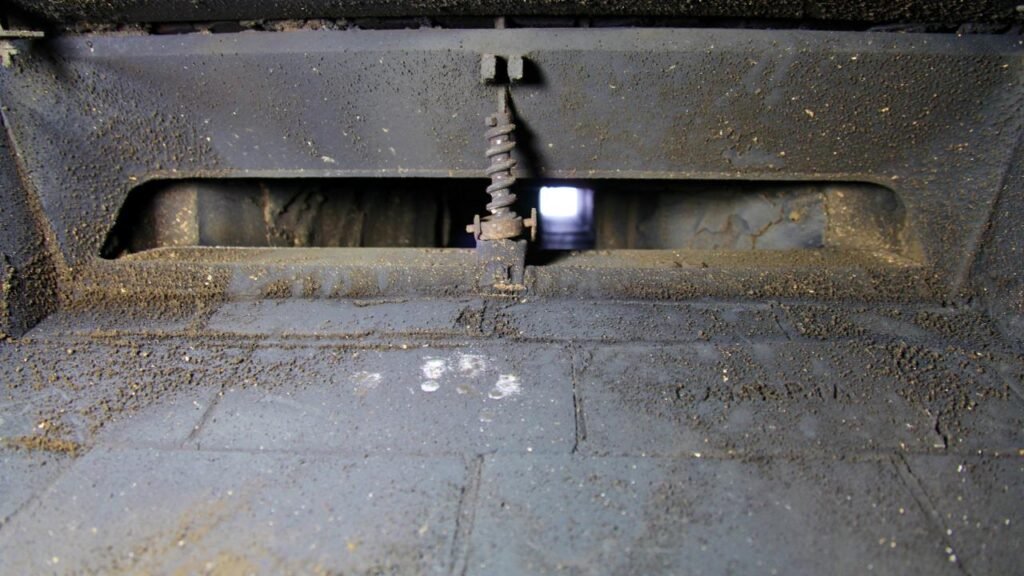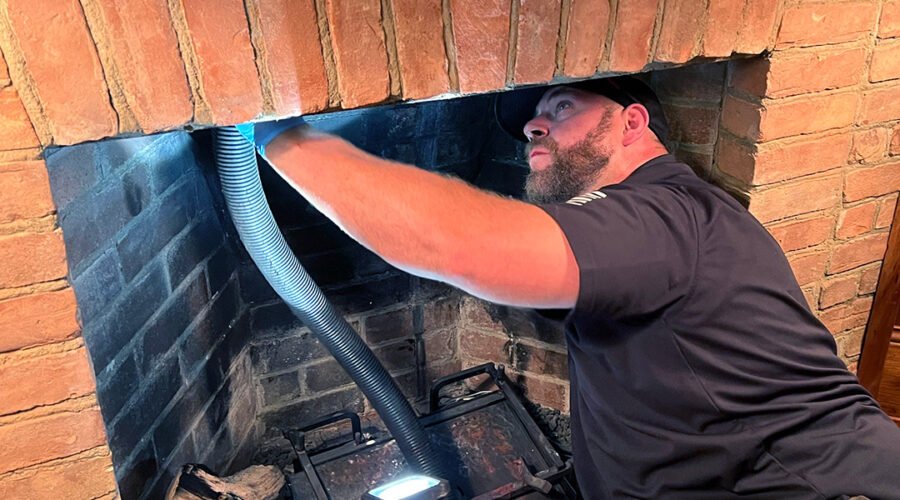Chimney Damper Repair: Tips for Maintenance, Signs of Damage & When to Call a Professional
Key Takeaways
- A chimney damper is essential for controlling airflow, preventing heat loss, and ensuring fireplace safety, making its maintenance a vital part of home care.
- Common damper issues include drafts, visible damage like rust, and difficulty operating, which can lead to increased energy bills and safety hazards if ignored.
- Regular cleaning and seasonal inspections help identify problems like debris buildup or seal wear, maintaining damper efficiency and longevity.
- Minor repairs, such as stuck damper fixes or seal replacement, can restore functionality, while severe damage may require full damper replacement for optimal performance.
- Airtight and energy-efficient dampers are effective solutions for reducing heat loss and boosting energy efficiency in modern homes.
- Professional evaluations and maintenance ensure chimney dampers operate safely and effectively, preventing costly repairs and improving energy savings.
A functioning chimney damper is essential for maintaining energy efficiency and ensuring safety in our homes. When it’s damaged or stuck, we risk losing heat, increasing utility bills, and even exposing ourselves to harmful drafts or smoke. Yet, many of us overlook this small but critical component until it becomes a noticeable problem.

Understanding Chimney Dampers
A chimney damper plays a critical role in controlling airflow and maintaining energy efficiency. It keeps warm air inside when the fireplace isn’t in use and prevents drafts and debris from entering your home.
What Is A Chimney Damper?
A chimney damper is a mechanism inside the flue that seals the chimney when it’s not in use. It’s essential for regulating fireplace draft control and preventing heat loss. Operating through an open-close mechanism, it allows smoke to escape during a fire and seals the airflow when the fireplace is idle.
Dampers also enhance energy efficiency by reducing the gap between your home and the outdoors. Without a properly working damper, utility bills can increase due to constant heat loss. Regular chimney damper inspections ensure damper functionality, avoiding problems like drafts or smoke backing into your living space.
If the damper is damaged or stuck, repairs like a broken damper fix or damper adjustment might be required. Damper replacement is recommended for severely worn-out mechanisms to maintain efficiency.
Common Types Of Chimney Dampers
Understanding different types of dampers can help identify the best solution for your chimney.
- Throat Dampers: Installed near the base of the flue, these are traditional dampers made of metal. They can corrode or warp over time, often leading to issues like stuck damper repair.
- Top-Sealing Dampers: Installed at the chimney top, these airtight dampers double as a cap, preventing water, debris, and animals from entering. They’re energy-efficient dampers ideal for modern homes.
- Cast-Iron Dampers: Durable but heavy, these dampers are commonly found in older fireplaces and may need damper seal repair to maintain performance.
- Rotary Dampers: Operated with a handle or knob, these provide simple adjustment but may not offer the most airtight solution.
Choosing an appropriate damper ensures effective fireplace operation. Whether you’re dealing with a worn-out seal or considering damper replacement, consulting a professional ensures long-term safety and efficiency.
For expert advice, the National Fire Protection Association (NFPA) offers guidelines for fireplace and chimney safety: NFPA Fireplace Safety. For chimney maintenance and repair tips, visit the Chimney Safety Institute of America: CSIA Resources.
Signs You Need Chimney Damper Repair
Recognizing early signs of a failing chimney damper helps maintain energy efficiency and home safety. Ignoring these issues may lead to costly repairs or safety hazards.
Unusual Drafts Or Heat Loss
Uncontrolled drafts or noticeable heat loss signal damper functionality issues. If the chimney allows cold air in or warm air escapes even when the fireplace isn’t in use, the damper seal may be compromised.
- Persistent drafts can mean a stuck damper repair is needed.
- Increased heating bills suggest the damper isn’t sealing well, affecting your fireplace draft control.
- Unexplained temperature drops in rooms near the chimney imply potential damper adjustment or replacement.
If drafts are excessive, consider inspecting the damper or consulting professionals. The Chimney Safety Institute of America links poor damper functionality to energy inefficiency.
Difficulty Operating The Damper
Trouble opening or closing the damper points to mechanical problems.
- A stuck handle indicates rust or a broken damper fix is required.
- Resistance while adjusting can result from warped components or debris buildup.
- Inconsistent movement may suggest the need for damper replacement or lubrication.
Damper adjustment problems often worsen over time. Regular maintenance ensures smooth operation and prevents complete failure. Airtight dampers are particularly beneficial for minimizing such issues, enhancing long-term efficiency.
Visible Damage Or Rust
Rust, warping, or visible cracks are signs the damper has deteriorated.
- Corrosion on metal dampers weakens durability, calling for damper seal repair.
- Bent or damaged areas disrupt airflow control, increasing the risk of harmful drafts.
- Gaps or misaligned sections directly affect the damper’s energy efficiency.
Frequent chimney damper inspection prevents extensive damage. According to the National Fire Protection Association, identifying visible damage helps avoid larger safety risks. For the best results, prioritize professional evaluations to identify and address structural risks.
Steps Involved In Chimney Damper Repair
Repairing a chimney damper involves careful inspection, cleaning, evaluating components, and knowing when to engage a professional. Each step ensures the damper remains effective for fireplace draft control and maintaining energy efficiency. Let’s break it down.
Inspecting The Damper
We start by performing a thorough chimney damper inspection. Check for visible damage like cracks, rust, or stuck components. Test damper functionality by opening and closing it. Listen for resistance or grinding noises, which may indicate a stuck damper or debris blocking movement.
Examine the seal for wear and air gaps. An airtight damper is critical to prevent drafts and maintain energy efficiency. If we notice signs of rust or bent metal, it could lead to further mechanical issues. Professional tools sometimes reveal hidden issues undetectable to the naked eye.

Cleaning And Removing Debris
Blocked dampers often struggle with proper airflow, so clearing debris is essential. Common obstructions include soot, creosote buildup, bird nests, and fallen leaves. Using a brush designed for chimneys ensures a safe and effective cleaning process.
We clean gently to avoid damaging fragile components like damper seals. Removing buildup restores damper adjustment capabilities, improving efficiency and safety. For heavily clogged systems, it’s best to call a professional who uses advanced equipment to eliminate stubborn deposits.
Repairing Vs. Replacing Damper Components
Damaged parts require evaluation to decide between repair and replacement. Minor issues like a stuck damper or warped metal may need straightforward repairs like lubricating hinges or minor adjustments. A broken damper fix often involves replacing bent rods or restoring damaged seals.
Extensive rust, significant cracking, or warped parts impacting damper functionality might call for full damper replacement. Energy-efficient dampers like top-sealing models can significantly enhance performance while offering better longevity. Balancing cost, performance, and safety helps determine the best solution.
When To Call A Professional
Some problems require expert attention, especially with broken or extensively damaged parts. If damper seal repair seems insufficient, or draft issues persist even though cleaning, professional services ensure proper fixes. The NFPA recommends annual professional inspections for safety.
Experts can handle challenges like stuck damper repair or damper replacement efficiently, minimizing risks. Unresolved issues like draft persistence, heat loss, or mechanical failure can lead to more severe fire hazards. For reliable repairs and replacements, working with certified professionals ensures lasting results.
Preventive Maintenance For Chimney Dampers
Preventive care ensures chimney dampers operate efficiently and avoid costly repairs. Small actions like cleaning and inspections support damper functionality and reduce energy loss.
Regular Cleaning
A clean damper enhances fireplace draft control and prevents issues like stuck damper repair. Over time, soot, creosote, and debris can accumulate, limiting the damper’s movement and seal effectiveness.
- Remove Soot and Debris: Excess build-up can reduce damper adjustment precision and block proper airflow. Use a professional service to clear off residues safely.
- Check for Rust: Rust forms when dampers are exposed to moisture. It impacts airtight dampers and weakens their durability. Inspect and consult professionals for damper seal repair if rust is present.
- Schedule Cleaning Appointments: Cleaning every 1-2 years, or before heavy fireplace use, ensures better energy efficiency and prevents costly fixes like broken damper repair.
Neglecting cleaning leads to residue build-up, which is no laughing matter—it clogs your draft and your wallet.
Seasonal Inspections
Regular chimney damper inspections detect issues before they escalate. Seasonal checks help maintain damper functionality and fireplace safety.
- Inspect Seals and Movement: Damper seal integrity prevents heat loss. Check if the damper moves freely without getting stuck. Professionals can repair or suggest damper replacement if needed.
- Assess Airtightness: Energy-efficient dampers should block drafts when closed. Gaps or failures in sealing indicate the need for damper adjustments.
- Monitor Weather Impact: Winter’s freeze and thaw cycles can cause cracks or misalignment. Fall inspections prepare your unit for heavy use during colder months.
Routine inspections help catch minor issues instead of facing major headaches—or smoke-filled surprises.
Conclusion
Maintaining damper functionality is essential for energy efficiency and home safety. A well-sealed damper prevents heat loss and controls fireplace drafts, ensuring comfort and reduced utility bills. Signs like difficulty operating the damper or unusual drafts often point to repair needs.
When addressing chimney damper issues, professional inspections play a critical role. From minor stuck damper repair to comprehensive damper seal repair or full damper replacement, trained experts ensure effective solutions. Rust, debris buildup, or damaged components can impact damper performance, and ignoring these problems may lead to costly energy waste or safety hazards.
For specialized dampers, such as airtight dampers or energy-efficient dampers, regular maintenance and adjustments help retain their longevity and performance. Cleaning and inspecting the damper every 1–2 years or before heavy fireplace use prevents blockages and preserves proper functionality. Seasonal chimney evaluations also help catch potential problems early, from broken damper fixes to ensuring a secure damper seal.
Remember, while chimney repairs might seem straightforward, consulting professionals ensures work adheres to safety standards.
Frequently Asked Questions
What Are Common Signs That My Damper Needs Repair?
Signs include drafts entering your home, difficulty operating the damper, or visible damage like rust. These issues disrupt damper functionality and compromise fireplace draft control. Unchecked, they may lead to energy loss or smoke backup. If you notice these problems, scheduling a chimney damper inspection is essential to prevent further damage.
How Do Professionals Repair a Stuck Damper?
Repairing a stuck damper starts with removing soot, creosote, or debris causing the obstruction. If mechanical parts are rusted or damaged, professionals may recommend damper adjustment or a full broken damper fix. We don’t advise DIY attempts, as improper handling can worsen the issue. Always contact a certified specialist for safe and efficient repair.
Is Damper Replacement Always Necessary for Damage?
Not always. Minor issues, like damaged seals or minor rust, can often be resolved with precise damper seal repair. But, extensive damage, such as warped parts or significant rusting, may require damper replacement. Professionals assess each case to determine the most cost-effective and energy-efficient solution.
Are Airtight Dampers Really Energy Efficient?
Yes, airtight dampers significantly enhance energy efficiency. These modern dampers create a tight seal, keeping warm air inside and blocking outdoor drafts. They’re a worthwhile upgrade if you’re concerned about reducing heat loss and lowering energy bills, especially in colder seasons.
How Often Should Chimney Dampers Be Inspected?
Regular chimney damper inspection is crucial for maintaining efficiency and safety. We suggest scheduling inspections annually, particularly before the heating season. This proactive approach helps catch small issues before they turn into costly repairs.
Can a Damaged Damper Affect My Fireplace Draft?
Absolutely. A poorly functioning damper disrupts fireplace draft control, allowing smoke or cold air to enter your living space. This not only affects comfort but may also pose a safety hazard. Prompt repairs ensure proper airflow and increase fireplace efficiency.


